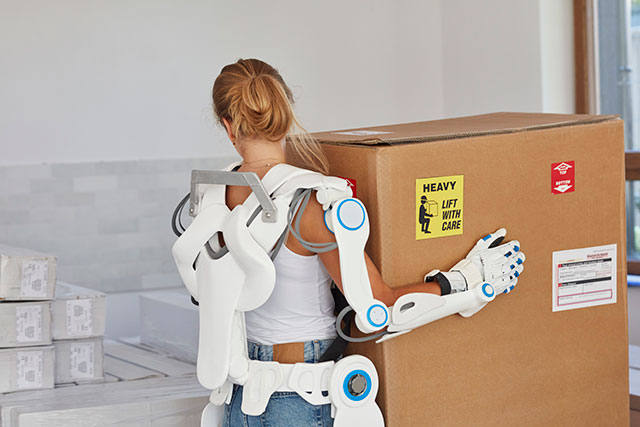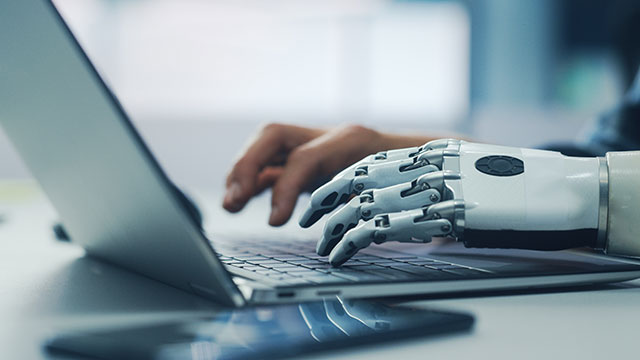FORWARD
Human Machine Augmentation: How will it impact on the
future workplace?
If you've ever watched a movie where cyborgs or other advanced machines with human-like capabilities are commonplace, you may have thought, "that would be pretty cool." Well, it turns out that this future isn't so far off.
With the rapid development of technology, the concept of human-machine augmentation is becoming more and more realistic.
Humans have always looked for ways of using technology to enhance their work output. From agricultural advances like the plow to the industrial revolution, technology has played a part in making our work easier and more efficient. The next step in this journey is human-machine augmentation (HMA).
Let's look at what HMA is, how it will impact the workplace, and what the future might hold for this exciting technology.
What is Human Machine Augmentation?
HMA is the process of using technology to improve or supplement human cognitive and physical abilities. It has been used in various forms for many years, such as in military and industrial settings. Instead of being replaced by machines, workers are equipped with tools and technologies that help them to work more effectively.
With HMA, technology and humans work together to create a symbiotic relationship that enhances both parties.
This type of augmentation is different from the human-computer interface (HCI), which is where humans use technology to interact with computers. With HMA, technology and humans work together to create a symbiotic relationship that enhances both parties.
There are many potential applications for HMA. For example, it could be used to improve safety in hazardous environments, increase productivity in manual tasks or even help people with disabilities to live more independent lives.
How will Human Machine Augmentation impact the workplace?
Perhaps, the most popular way that HMA is being used currently is in the form of wearable technology. What started as smartwatches to track fitness data has now evolved into full-fledged wearable computers. These devices are becoming more and more powerful, with the latest models featuring processors, storage, and sensors that rival those found in smartphones.
Google's Project Glass is one of the most well-known examples of HMA in the consumer space. This wearable computer features a head-mounted display that gives users information about their surroundings and allows them to interact with various applications using natural language voice commands. It allows users to take photos, send messages, and access information without ever having to use their hands.
Firefighters could use AR visors to see the floor plan of a burning building and find the safest route to the exit. Doctors could use AR to view a patient's vital signs and medical history while performing surgery.
While Project Glass is still in its early stages, it shows the potential that HMA has for transforming the way we work. The glasses work in tandem with AR (augmented reality) applications to provide information that would otherwise be hidden from view. For example, imagine a construction worker who can see real-time data about the building he is working on.
AR in a work setting is not just limited to construction workers. In some cases, it could be life-saving. For example, firefighters could use AR visors to see the floor plan of a burning building and find the safest route to the exit. Doctors could use AR to view a patient's vital signs and medical history while performing surgery.
Exo-suits
Also called exoskeletons, these contraptions are essentially wearable robots that provide physical support to the wearer. An exo-suit can assist with lifting heavy objects or provide extra stability when walking or standing.
Exo-suits are already being used in industrial settings to help workers who have to perform repetitive tasks that strain their bodies. The Hyundai Motor Group uses exo-suits to help workers working in overhead environments. The Vest EXoskeleton (VEX) helps to take the weight of tools off the worker's arms and shoulders, reducing the risk of musculoskeletal injuries.

With the possibility of supporting every problematic body movement, the potential for exo-suits in the workplace is huge. It could even allow older workers to stay in the workforce for longer, as it would allow them to compensate for any age-related decline in physical strength.
Of course, the military is also interested in the potential of exo-suits. The US military is currently testing various prototypes to see how they can be used in combat situations. One example is the Soldier Assistive Bionic Exosuit for Resupply, aka SABER. Weighing only three pounds, this exo-suit is designed to help soldiers carry heavy loads over long distances. From ammunition to fallen comrades, SABER can help lighten the load for soldiers in combat.
Prosthetics
Prosthetics are perhaps the oldest form of HMA, with early examples dating back to Ancient Egypt. Today, they have come a long way from being basic replacements for lost limbs. Modern prosthetics can be customized to the individual and offer various functions.
One example is the iLimb Ultra, an artificial hand that can be controlled using muscle movements in the arm. The hand has 18 different grip patterns that can be selected using a rotary dial on the wrist. With this technology, amputees will no longer be excluded from doing tasks requiring precise grip. For example, they can turn a doorknob or use a computer mouse.

Brain-computer interfaces
A brain-computer interface (BCI) is a system that allows communication between the brain and an external device. BCIs are still in their early stages, but they show great potential for humans to control machines with their thoughts.
As information flows through your visual cortex, the chip will be able to decode this information and translate it into digital form. Thus, you can effectively control a computer or smartphone with your thoughts.
Neuralink, Elon Musk's brain-machine interface company, is one example of BCI technology. Their goal is to create a brain-machine interface that will allow humans to control devices with their thoughts. The company has already created a chip that can be implanted into the brain. This chip then connects to an external device, such as a computer or smartphone. As information flows through your visual cortex, the chip will be able to decode this information and translate it into digital form. Thus, you can effectively control a computer or smartphone with your thoughts.
In the workplace, BCIs could be used to control machinery or to access information. In turn, we could use thoughts to operate a forklift or to call up data on a computer screen. It would allow workers to work more efficiently and would reduce the risk of injuries caused by accidents.
Artificial intelligence
Artificial intelligence (AI) is a form of HMA that is already transforming the workplace. With the rise of machine learning, AI is becoming more sophisticated and being used in various industries. With the help of a human operator, AI can now write, draw, translate, and even invent.
In the case of DALL-E, an AI program created by OpenAI, we see how artists can use AI to create art. DALL-E is an AI program that can generate images from textual descriptions. When given the description "a robot riding a horse," DALL-E will create a picture of a robot riding a horse, pixel by pixel. Marketers, advertisers, and even architects can use DALL-E to create images for their products or services.
Conclusion
In conclusion, human-machine augmentation is a rapidly growing field with many potential applications. From exo-suits to brain-computer interfaces, HMA is changing how we live and work. In the future, HMA will continue transforming the workplace and help us become more efficient and productive.
While machines may not entirely replace us, HMA will change the dynamic at work. With the help of HMA, we will be able to do things that were
once impossible.